从句的种类和区别
考研英语语法: 学会辨认六类从句
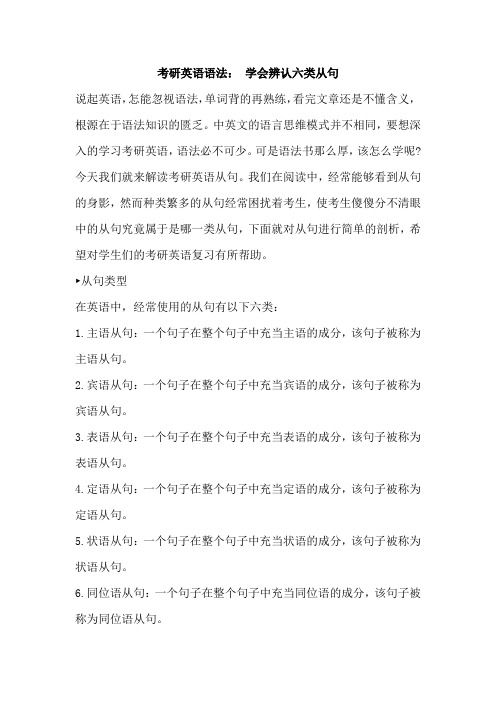
考研英语语法:学会辨认六类从句说起英语,怎能忽视语法,单词背的再熟练,看完文章还是不懂含义,根源在于语法知识的匮乏。
中英文的语言思维模式并不相同,要想深入的学习考研英语,语法必不可少。
可是语法书那么厚,该怎么学呢?今天我们就来解读考研英语从句。
我们在阅读中,经常能够看到从句的身影,然而种类繁多的从句经常困扰着考生,使考生傻傻分不清眼中的从句究竟属于是哪一类从句,下面就对从句进行简单的剖析,希望对学生们的考研英语复习有所帮助。
►从句类型在英语中,经常使用的从句有以下六类:1.主语从句:一个句子在整个句子中充当主语的成分,该句子被称为主语从句。
2.宾语从句:一个句子在整个句子中充当宾语的成分,该句子被称为宾语从句。
3.表语从句:一个句子在整个句子中充当表语的成分,该句子被称为表语从句。
4.定语从句:一个句子在整个句子中充当定语的成分,该句子被称为定语从句。
5.状语从句:一个句子在整个句子中充当状语的成分,该句子被称为状语从句。
6.同位语从句:一个句子在整个句子中充当同位语的成分,该句子被称为同位语从句。
►从句的辨认如果想辨认从句类型,学生们应该对从句的基本形式有所认识。
无论是哪种从句类型,在句子中充当成分的"句子"应该都具备以下特征:从句=从属连词+句子了解了从句的基本结构,那么应该如何辨别从句类型呢?学生可以在句子中通过简单的公式进行辨认。
常见的从句出现形式有四类:1.名词+从属连词+句子=定语从句/同位语从句2.动词+从属连词+句子=宾语从句/表语从句3.[从属连词+句子=状语从句]+句子4.从属连词+句子+动词=主语从句对于以上四类从句出现形式有了一定的了解,那么今天就首先看看第一类从句出现形式的辨认方法和注意事项吧!1.名词+从属连词+句子=定语从句/同位语从句文都教育教学研究院11例子1: Yet, being friendly is a virtue that many Americans value highly and expect from both neighbors and strangers. (1997 年 Text2)从句类型:定语从句辨别方式: a virtue(名词)+that(从属连词)+many Americans value highly and expect from both neighbors and strangers(句子)译文:然而,表示友好是一种美德,美国人高度重视这种美德,并期望邻居和陌生人都能有这种美德。
名词性从句的种类与作用

名词性从句的种类与作用名词性从句是指在句子中充当名词的句子成分,它能够承担名词所具有的各种功能,如主语、宾语、表语、同位语等。
名词性从句的使用可以使句子更加丰富,表达更加准确。
本文将介绍名词性从句的种类及其作用。
一、主语从句主语从句是名词性从句的一种常见形式,它在句子中充当主语的角色,起到句子的主题和核心的作用。
主语从句通常以“that”或“whether”引导。
例如:1. That he is a talented musician is well known to everyone.2. Whether she will come to the party is still uncertain.主语从句常常用于强调句和形式主语的表达中,使句子更加生动有力。
二、宾语从句宾语从句作为动词的宾语出现,可以回答“what”、“where”、“which”、“who”等疑问词引导的问题。
它常见于及物动词后,也可用于介词后。
例如:1. She asked me what I wanted for dinner.2. He told me where he had been yesterday.宾语从句的作用是充当动词的宾语,使句子更加完整,表达更加准确。
三、表语从句表语从句用来修饰名词或代词,充当表语的角色,常以“that”或“whether”引导。
表语从句通常出现在“be”动词后或感官动词后。
例如:1. The question is whether we should go or stay.2. His wish is that he could travel around the world.表语从句可以在句中起到进一步解释、说明或补充的作用,使句子更加丰富多样。
四、同位语从句同位语从句指的是对名词或代词进行解释、说明或补充的句子,常见于名词后面,起到进一步解释名词的作用。
同位语从句通常以“that”引导。
从句一览表
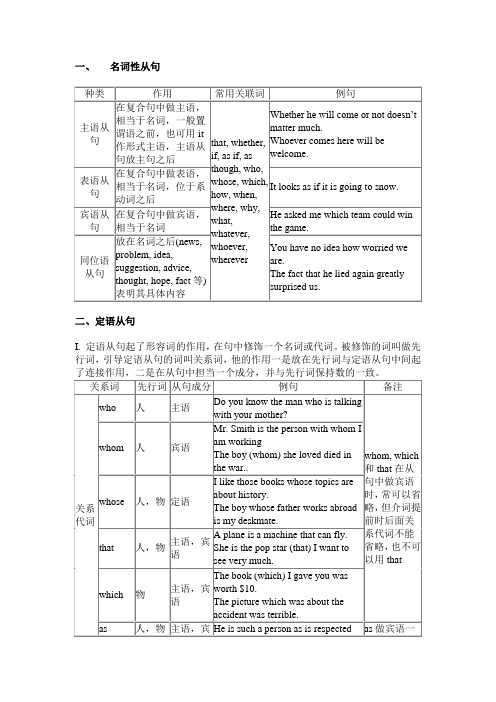
同位语从句
放在名词之后(news, problem, idea, suggestion, advice, thought, hope, fact等)表明其具体内容
You have no idea how worried we are.
I like the person to whom the teacher is talking.
Those who respect others are usually respected by others.
III. as与which的区别:
定语从句
区别
例句
限制性定语从句中
名词前有such和the same修饰时,关系代词用as,不能用which
关系词
先行词
从句成分
例句
备注
关系代词
who
人
主语
Do you know the man who is talking with your mother?
whom, which和that在从句中做宾语时,常可以省略,但介词提前时后面关系代词不能省略,也不可以用that
whom
人
宾语
Mr. Smith is the person with whom I am working
The boy (whom) she loved died in the war..
whose
人,物
定语
I like those books whose topics are about history.
The boy whose father works abroad is my deskmate.
主语从句、表语从句
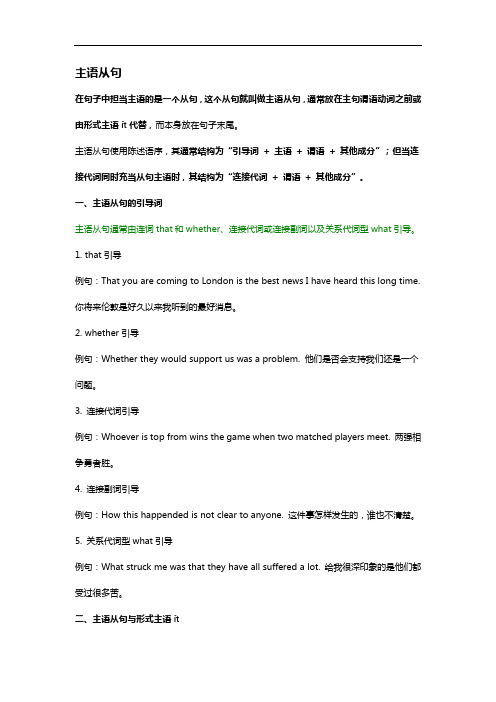
主语从句在句子中担当主语的是一个从句,这个从句就叫做主语从句,通常放在主句谓语动词之前或由形式主语it代替,而本身放在句子末尾。
主语从句使用陈述语序,其通常结构为“引导词+ 主语+ 谓语+ 其他成分”;但当连接代词同时充当从句主语时,其结构为“连接代词+ 谓语+ 其他成分”。
一、主语从句的引导词主语从句通常由连词that和whether、连接代词或连接副词以及关系代词型what引导。
1. that引导例句:That you are coming to London is the best news I have heard this long time. 你将来伦敦是好久以来我听到的最好消息。
2. whether引导例句:Whether they would support us was a problem. 他们是否会支持我们还是一个问题。
3. 连接代词引导例句:Whoever is top from wins the game when two matched players meet. 两强相争勇者胜。
4. 连接副词引导例句:How this happended is not clear to anyone. 这件事怎样发生的,谁也不清楚。
5. 关系代词型what引导例句:What struck me was that they have all suffered a lot. 给我很深印象的是他们都受过很多苦。
二、主语从句与形式主语it有时为了考虑句子平衡,通常在主语从句处使用形式主语it,而将真正的主语从句移至句末。
这分三种情况:(1) 对于以连词that引导的主语从句,通常用形式主语代主语从句:例句:That they should refuse to sign the petition required great courage. 他们拒绝在请愿书上签字这是需要很大勇气的。
(2) 对于以连接代词(副词)引导的主语从句,可以使用形式主语代主语从句,也可直接在句首使用主语从句:例句:Whether they would support us was a problem. 他们是否会支持我们还是一个问题。
从句的种类与用法详细解析
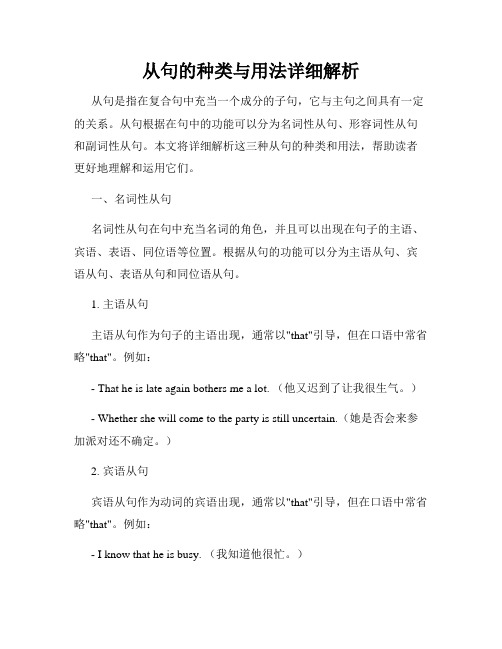
从句的种类与用法详细解析从句是指在复合句中充当一个成分的子句,它与主句之间具有一定的关系。
从句根据在句中的功能可以分为名词性从句、形容词性从句和副词性从句。
本文将详细解析这三种从句的种类和用法,帮助读者更好地理解和运用它们。
一、名词性从句名词性从句在句中充当名词的角色,并且可以出现在句子的主语、宾语、表语、同位语等位置。
根据从句的功能可以分为主语从句、宾语从句、表语从句和同位语从句。
1. 主语从句主语从句作为句子的主语出现,通常以"that"引导,但在口语中常省略"that"。
例如:- That he is late again bothers me a lot. (他又迟到了让我很生气。
)- Whether she will come to the party is still uncertain.(她是否会来参加派对还不确定。
)2. 宾语从句宾语从句作为动词的宾语出现,通常以"that"引导,但在口语中常省略"that"。
例如:- I know that he is busy. (我知道他很忙。
)- Can you tell me where the nearest supermarket is?(你能告诉我最近的超市在哪里吗?)3. 表语从句表语从句用来说明主语的特征或状态,通常以"that"引导,但在口语中常省略"that"。
例如:- The truth is that he is a liar.(事实是他是个骗子。
)- What makes me happy is that we will have a long holiday.(让我开心的是我们将有一个长假。
)4. 同位语从句同位语从句用来解释、说明或补充名词,通常以"that"引导,但在口语中常省略"that"。
从句的种类和用法详解

从句的种类和用法详解从句是英语语法中重要的一个部分,由一个主句和一个或多个从句组成。
从句可以增加语言的表达力,使句子更加丰富多样。
本文将详细解释从句的种类和用法,帮助读者更好地理解和运用从句。
一、名词性从句名词性从句在句子中充当名词的功能,可以作主语、宾语、表语或补语。
常见的名词性从句有三种种类:主语从句、宾语从句和表语从句。
1. 主语从句主语从句在句子中充当主语的角色,常以"that"引导。
例如:"That he is late surprises me."(他迟到了让我感到惊讶。
)2. 宾语从句宾语从句在句子中充当动词的宾语,通常由"that"引导,但在口语中可以省略。
例如:"I believe that he will come." (我相信他会来。
)"I know he will come." (我知道他会来。
)3. 表语从句表语从句在句子中充当表语的角色。
例如:"The important thing is that you try your best."(最重要的是你尽力而为。
)二、定语从句定语从句用来修饰名词或代词,常以关系代词或关系副词引导。
定语从句通常紧跟在被修饰的名词或代词之后。
例如:"The man who is speaking is my teacher."(正在说话的那个人是我的老师。
)"The book that I borrowed from the library is interesting."(我从图书馆借的那本书很有趣。
)三、状语从句状语从句用来表达时间、条件、原因、结果、目的、比较等信息,在句子中充当状语的角色。
根据不同的用途,状语从句可以分为六种类型。
1. 时间状语从句时间状语从句用来表示一个动作或事件发生的时间。
从句的知识点总结
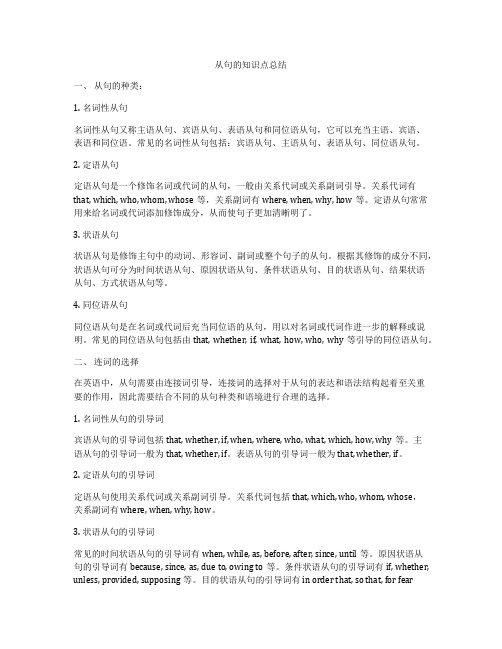
从句的知识点总结一、从句的种类:1. 名词性从句名词性从句又称主语从句、宾语从句、表语从句和同位语从句,它可以充当主语、宾语、表语和同位语。
常见的名词性从句包括:宾语从句、主语从句、表语从句、同位语从句。
2. 定语从句定语从句是一个修饰名词或代词的从句,一般由关系代词或关系副词引导。
关系代词有that, which, who, whom, whose等,关系副词有where, when, why, how等。
定语从句常常用来给名词或代词添加修饰成分,从而使句子更加清晰明了。
3. 状语从句状语从句是修饰主句中的动词、形容词、副词或整个句子的从句。
根据其修饰的成分不同,状语从句可分为时间状语从句、原因状语从句、条件状语从句、目的状语从句、结果状语从句、方式状语从句等。
4. 同位语从句同位语从句是在名词或代词后充当同位语的从句,用以对名词或代词作进一步的解释或说明。
常见的同位语从句包括由that, whether, if, what, how, who, why等引导的同位语从句。
二、连词的选择在英语中,从句需要由连接词引导,连接词的选择对于从句的表达和语法结构起着至关重要的作用,因此需要结合不同的从句种类和语境进行合理的选择。
1. 名词性从句的引导词宾语从句的引导词包括that, whether, if, when, where, who, what, which, how, why等。
主语从句的引导词一般为that, whether, if。
表语从句的引导词一般为that, whether, if。
2. 定语从句的引导词定语从句使用关系代词或关系副词引导。
关系代词包括that, which, who, whom, whose,关系副词有 where, when, why, how。
3. 状语从句的引导词常见的时间状语从句的引导词有when, while, as, before, after, since, until等。
英语中的各种从句详解

从句一.名词性从句在句子中起名词作用的各种从句统称为名词性从句。
这类从句在句中可担任主语、表语、宾语和同位语,名词从句可以分为主语从句、表语从句、宾语从句和同位语从句。
1.主语从句在句子中担当主语的是一个句子,这个从句就叫作主语从句。
主语从句可以由下列连词、连接代词和连接副词引导,且不能省略。
连词:that, whether连接代词:what, whatever, who, whoever 等连接副词:when, where, how, why(1)由连词that, whether引导的主语从句连词that, whether在从句中的作用只是引导主语从句,它在从句中不担任成分,不能省略,且由that, whether 引导的主语从句,多用it多形式主语e.g That the earth is round is true.=It is true that the earth is round.地球是圆的,是一个事实。
Whether he’ll come or not hasn’t been decided.= It hasn’t been decided whether he’ll come or not.(2)由连接代词或连接副词引导的主语从句连接代词who, which和连接副词when, where, how, why都可以引导主语从句,它们分别在从句中担任主语、宾语和状语,不能省略,翻译时,不能把它们译为疑问句,由它们引导的主语从句,也可以用形式主语it 引导e.g Who let out the news remained unknown. =It remained unknown who let out the news.谁泄漏了那个消息仍旧无人知道。
When we’ll start is not clear.=It is not clear when we’ll start.我们何时出发还不清楚。
从句的知识点总结

从句的知识点总结一、从句的概念。
从句是复合句中不能独立成句,但具有主语部分和谓语部分,由that、who、whom、when、why、where、how、which等引导词引导的非主句部分。
二、从句的种类。
1. 名词性从句。
- 主语从句。
- 定义:在复合句中充当主语的从句。
- 引导词:that(无意义,不充当成分,只起连接作用,但不可省略)、whether (是否)、连接代词(what、who、which等,在从句中充当主语、宾语、表语等成分)、连接副词(when、where、how、why等,在从句中作状语)。
- 例如:That he will come is certain.(“That he will come”是主语从句,that无意义,不充当成分,“他会来”这件事是确定的)- 宾语从句。
- 定义:在复合句中作宾语的从句。
- 引导词与主语从句基本相同。
- 例如:I know that he is a good student.(“that he is a good student”作know的宾语)- 注意点:- 宾语从句的时态要与主句时态相呼应。
如果主句是一般现在时,从句根据实际情况使用各种时态;如果主句是一般过去时,从句要用相应的过去时态(一般过去时、过去进行时、过去将来时、过去完成时),但如果从句表示的是客观真理、自然现象等,从句时态不变,仍用一般现在时。
- 宾语从句要用陈述句语序,即主语在前,谓语在后。
- 表语从句。
- 定义:在复合句中作表语的从句。
- 引导词也与主语从句类似。
- 例如:The problem is when we can get a pay rise.(“when we can get a pay rise”作is的表语,说明问题是什么)- 同位语从句。
- 定义:用来解释说明前面某一名词(如fact、idea、news、promise等)的内容的从句。
- 引导词:that(无意义,不充当成分,不可省略)、whether(是否)等。
英语从句辨析50个例句

英语从句辨析50个例句英语从句是英语语法中的一个重要部分,主要包括名词性从句、定语从句和状语从句。
以下是50个例句,用于帮助辨析不同类型的英语从句:一、名词性从句1、主语从句:What he said is not true.(他说的不是真的。
)2、宾语从句:I don't know if he will come.(我不知道他是否会来。
)3、表语从句:The question is who will go there.(问题是谁会去那里。
)4、同位语从句:The news that he resigned was surprising.(他辞职的消息令人惊讶。
)5、主语从句:Whether he will come or not remains uncertain.(他是否会来还不确定。
)6、宾语从句:I doubt whether he can finish the task on time.(我怀疑他是否能按时完成任务。
)7、表语从句:The question is when we should start the project.(问题是我们应该何时开始这个项目。
)8、同位语从句:The fact that she won the prize was a great honor for her family.(她获奖的事实对她家来说是一种极大的荣誉。
)9、The question whether we should proceed with the project remains unanswered. (我们是否应该继续这个项目的问题尚未回答。
)10、It's a fact that the company is going through a tough period. (公司正在经历困难时期,这是事实。
)11、The reason why he resigned was not made public. (他辞职的原因没有公开。
从句在句子结构中的位置是怎样的?

从句在句子结构中的位置是怎样的?1. 从句的定义与分类从句是构成复句的一个核心成分,具有主谓结构,可以独立完成一定的语法功能。
根据从句的不同功能,可以分为主语从句、宾语从句、表语从句、定语从句和状语从句等多种类型。
1.1 主语从句:位于主句谓语动词之前,充当主语的成分。
1.2 宾语从句:通常位于主句动词之后,充当主句谓语动词的宾语。
1.3 表语从句:位于主句谓语动词之后,充当主句的表语。
1.4 定语从句:位于名词或代词之后,用来修饰名词或代词。
1.5 状语从句:位于主句之前或之后,用来表示原因、条件、目的、结果等。
2. 从句在句子中的位置从句在句子结构中的位置取决于从句的种类和功能,一般可以分为紧跟主句、置于主句之前和置于主句之后三种情况。
2.1 紧跟主句:主语从句和宾语从句经常紧跟在主句之后,与主句构成一个完整的复句结构。
2.2 置于主句之前:表语从句和定语从句常常位于主句之前,修饰主句的主语或宾语。
2.3 置于主句之后:状语从句通常位于主句之前或之后,用来表达主句中的时间、原因、条件等相关信息。
3. 从句的语法功能与意义从句在句子中承担了重要的语法功能和意义,丰富了句子的表达方式,增加了句子的信息量和层次。
3.1 描述性句子:通过定语从句和表语从句,可以提供更加详尽的描述信息,丰富了句子的内容和意义。
3.2 表达因果关系:状语从句可以表达原因、条件、结果等因果关系,使得句子更加连贯和清晰。
3.3 扩展句子结构:主语从句、宾语从句等从句的加入,可以扩展句子的结构,增加句子的变化和灵活性。
4. 从句的运用技巧和注意事项在使用从句时,需要注意语法结构的正确性和逻辑关系的清晰性,避免产生歧义或表达错误。
同时,还可以根据需要灵活运用从句,以丰富和提高句子表达的效果。
4.1 注意时态和语态的搭配:在使用从句时,要注意从句与主句之间的时态、语态等搭配关系,确保句子整体语法结构的完整性。
4.2 避免过多从句:在句子中使用过多的从句会使句子复杂难懂,应该适当控制从句的数量,保持句子的简洁明了。
初中语文从句讲解

初中语文从句讲解什么是从句从句是句子的一部分,它不能独立成句,必须与主句组成完整的句子。
从句通常起到修饰主句或表达完整意思的作用。
从句的种类从句可以分为三种:名词性从句、定语从句和状语从句。
1. 名词性从句:名词性从句在句子中充当名词的角色,常常出现在主句中作主语、宾语或表语。
2. 定语从句:定语从句用来修饰名词,常常出现在主句中作定语。
3. 状语从句:状语从句用来表示时间、原因、条件等与主句相关的情况,常常出现在主句中作状语。
名词性从句名词性从句有三种类型:主语从句、宾语从句和表语从句。
1. 主语从句:主语从句在句子中作主语,常常以 "that" 引导,也可以用 "what" 或 "whether" 引导。
例如:- That he failed the exam is not surprising.(他考试不及格并不令人惊讶。
)- What he said is true.(他说的是真的。
)2. 宾语从句:宾语从句在句子中作动词的宾语,常常以 "that" 引导。
例如:- I don't know what he likes.(我不知道他喜欢什么。
)3. 表语从句:表语从句在句子中作表语,常常以 "that" 引导。
例如:- The fact is that he is late.(事实是他迟到了。
)- My worry is that he might fail.(我担心的是他可能会失败。
)定语从句定语从句用来修饰名词,常常以 "that"、"which"、"who"、"whom"、"whose" 等引导。
例如:- The book that I borrowed is very interesting.(我借的那本书非常有趣。
状语从句类型及相似连词的用法区别

一、状语从句分类及常用连词:类别连词状语从句when, whenever, while, as, before, after, since, till, once, as soon as,etc.状语从句where,wherever状语从句because, since, as, for, now that, etc.状语从句so…that, so that, such…that, that, etc.状语从句in order that, so that, that, etc.状语从句if, unless, as(so)long as, etc.状语从句though, although, even if, even though, however, whatever, as,etc.状语从句as…as, so…as, than, etc.状语从句as, as if, as though, etc.二、相似连词的用法区别1.when, while, as,while表时间,从句需用延续性动词,切不可用瞬间动词。
when表时间,从句既可以用延续性动词,又可以用瞬间动词。
as表时间,与when相似,但侧重强调主从句动作同点或同段进行。
when, while后可以接分词短语。
2.because, as, since, for语气位置意义because最强前或后“原因”;表客观因果关系;回答“”as较强前“由于”;把众人所知的事实当作理由since较弱前“既然”;就对方陈述的事实作为理由for最弱后“理由”;对某一事实进行推断的理由注:上面所说的“前”,指从句在主句之前;“后”,指从句在主句之后。
3.so that, so…that, such…thatso that“以便”、“结果”表目的和结果。
注意:在从句中有情态动词表目的。
无情态动词表结果。
so…that “如此的…以致于”表结果。
该结构常见于:1.so+形/副+that2.so+形+a(an)+单数名词+that3.so+manymuch+复数名词(不可数名词)+thatsuch…that“如此的…以致于”表结果。
英语各种从句的用法

英语中从句包括:名词从句、定语从句、同位语从句和状语从句.一、名词从句包括主语从句、宾语从句和表语从句.(一)主语从句考试重点:主语从句常用的连词的用法;it is desirable that引导的主语从句的用法.在句子中担当主语的是一个从句,这个从句就叫主语从句.主语从句可以由下列连词、连接代词和连接副词引导,且不能省略.连词:that,whether 连接代词:what,whatever,who,whoever等.连接副词:when,where,how,why1、由连词that,whether引导的主语从句.连词that,whether在主语从句中的作用只是引导主语从句,它在从句中不担任成分,不能省略,且由它们引导的主语从句,多用it做形式主语.(1)_____ was unimportant.A. Whether he enjoyed our dinner or notB. No matter how he enjoyed our dinnerC. If he enjoyed our dinnerD. What he enjoyed our dinner2)That the earth is round is true.(It is true that the earth is round.)地球是圆的,是个事实.2、由连接代词和连接副词引导的主语从句它们分别在从句中担任主语、宾语和状语,不能省略.注意翻译时不能把它们译为疑问句.由它们引导的主语从句,也可以用形式主语it引导.(1)Who let out the news remained unknown.(It remained unknown who let out the news.)谁泄露了那个消息仍旧无人知道.(2)When we’ll start is not clear.(It is not clear when we’ll start.)我们何时出发还不清楚.3、以连接代词what, whatever, whoever…引导的主语从句.What有时可以用来表示the thing which这种意思,引导从句,表示一样东西或一件事情.Who,whom,which,what,可以和ever构成合成词,和what一样引导从句,ever起强调作用.此类句子不能用形式主语it引导,它们在句子中担任成份,不能省略,语序为陈述句的语序.(1)_____ I saw was two men crossing the street.A. WhatB. WhomC. WhoD. That4、句型It is desirable (suggested, necessary, requested, ordered, proposed, urgent)+that+主语+should(可省略)+V(动词原形).(1)It’s urgent that a meeting _____ before the final decision is made.A. will be arrangedB. must be arrangedC. be arrangedD. would be arranged(二)表语从句考试重点:表语从句的基本用法;含有suggestion,proposal等词的表语从句的用法.1、在从句中做表语的从句叫表语从句.它位于主句中的系动词之后,常用的关联词和主语从句相同.(1)This is what he wants. 这就是他想要的东西.(2)The question is whether we can finish our work by tomorrow morning.问题是我们明天上午能否完成任务.2、用suggestion等词表示愿望、建议、命令等情绪时,用虚拟语气,从句中用should(可省略)+动词原形.(1)The general’s command was that the soldiers _____ their fort and carry out more important tasks.A. would leaveB. leaveC. leftD. have left(三)宾语从句考试重点:宾语从句用陈述句的语序;介词后面的宾语从句;suggest,insist,order,demand等动词后接宾语从句时,用虚拟语气;if和whether 的区别.1、宾语从句用陈述句的语序(1)Can you tell me _____ about the city that makes people love it so much?A. it is whatB. what it isC. what is itD. is it what2、介词后面的宾语从句(1)The people at the party were worried about Janet because no one was aware _____ she had gone.A. where thatB. of whereC. of the placeD. the place3、suggest,insist,order,demand等动词后作宾语时,表示欲望、建议、命令等时,用虚拟语气.①His mother insisted that he _____ the coat when going out.A. put onB. puts onC. to putD. putting on4、在下列情况下不能用if , 而用whether.后跟不定式:He didn’t tell me whether to go or stay. 他没有告诉我是走还是留下.前面有介词:He raised the question of whether we could find the necessary money.他提出我们能否筹集到必要的资金这个问题.引导主语从句:Whether they win or lose is all the same to me.他们胜利也好,失败也好,对我来说都是一样的.后面直接跟or not:I wonder whether I’ll catch the last bus or not.我不知道我能否赶上末班车.(四) 同位语从句常跟在fact,idea,news等名词的后面,通常用连词that引导.1、Would the news _____ he failed to pass the exam bother you?A. whichB. thatC. of whichD. on which2、I had no idea that you were here. 我没有想到你会在这里.如果同位语从句所修饰的先行词是suggestion,proposal等名词的时候,谓语动词用should+原形动词.should可以省略.1、My suggestion that we do the experiment again is accepted bythem.我的再做一次实验的建议被他们所接纳.2、His proposal that they(should)challenge the other groups to a friendly competition is praised by the teacher. 他提议他们和别的组挑战,来一场友谊竞赛.这个提议受到了老师的表扬.二、定语从句考试重点:限定性定语从句中关系代词的用法;关系副词when,where,why,引导的定语从句;带介词的定语从句;非限定性定语从句;“名词(代词)+介词+关系代词”引出,一般是非限定性定语从句.在复合句中起定语作用的从句叫做定语从句.定语从句分为两种:限定性定语从句和非限定性定语从句.注意关系代词和关系副词在从句中的应用.(一)关系代词who,whom,whose,which,that引导的定语从句1、The company official _____ I thought would be fired received a raise.A. whomB. whoeverC. whoD. of whom(二)关系副词when ,where, why, 引导的定语从句1、The time will come _____ man can fly to outer space freely.A. thatB. whenC. in thatD. which(三)关系代词前带介词的定语从句1、Before her marriage, she spent a considerable time in that very part of Shanghai, _____ she belonged.A. whichB. to whereC. to whichD. at which(四)非限定定语从句对被修饰的名词起附加说明,或进一步描述或补充.这种从句有一定的独立性,即使去掉,主句的意思仍然完整,只是内容相对地不够具体.与主句之间常用逗号分开,所用的关系代词与限定性定语从句基本相同,但不能用关系代词that 引导.(1)An Old friend from abroad, _____I was expecting to stay with, telephoned me from the airport.A. thatB. whomC. whoD. which (五)“名词(代词)+介词+关系代词”引出,一般是非限定性定语从句.We’ve tested three hundred types of boot, _____is completely water proof.A. no of whichB. none of whichC. some of whichD. neither of which 考试重点:同位语从句的基本用法;含有suggestion,proposal等词的同位语从句.三、状语从句在主从句中起状语作用的从句叫状语从句.常见的状语从句有时间、地点、条件、原因、让步、方式、比较、目的、结果.考试重点:状语从句的种类及一些连词的基本用法;让步状语从句;unless,supposed (that),whomever,whenever,wherever等连词的含义和用法.一)时间状语从句常用的连词有:when,whenever(无论什么时候),since,as,until,hardly…when,no sooner…than,as soon as,before,after,the moment,the minute(一…就…)1、No sooner had they got the goods covered up _____ it started raining hard.A. whenB. thanC. thenD. after二)条件状语从句常用if,unless(除非,如果不),as/so long as只要.1、_____ I’m mistaken, I’ve seen that man before.A. UnlessB. IfC. BecauseD. Provided三)、原因状语从句常用:because, as, since.如果表示必然的因果关系,一般用because引入;而since表示一种间接或附带的原因;用as 只是提一下.1、He cannot go to school because he is ill. 他因为生病不能上学.2、Everyone likes you as you are both kind and honest. 人人都喜欢你,因为你既和气,又诚实.四)让步状语从句常用though/although,as (尽管),even if/though,however,whatever,wherever,whoever,no matter how/what/who等.1、In short, _____ he lives, a man belongs to some society.A. whateverB. wheneverC. whicheverD. wherever2、_____, you must show your ticket to go into the cinema.A. No matter whoever you areB. Whomever you areC. Whoever you areD. No matter who are you五)方式状语从句常用as, just as, as if/though 等词.1、_____ was pointed above, this substance can be used as a substitute.A. ItB. ThatC. WhatD. As2、He talks as if he _____ everything in the world.A. knowsB. knewC. had knownD. would have known六)目的状语从句常用so that , in order that, lest (以免,以防), in case.1、I wrote it down _____ I should forget it.A. in caseB. in case ofC. in order thatD. for fear of2、I’ll give you my phone number, so that you can call me when you arrive here.我把我的电话号码告诉你,以便你到达这里后可以给我打电话.七)结果状语从句常用so…that, such…that They are _____ students that they all performed well in the nationwide examinations.专注于活动方案总结,小学初中高中试卷,可以编辑的文档,欢迎下载使用本文档来源网络,由于文档太多,审核有可能疏忽,如果有错误或侵权,请联系本店马上删除。
英语各种从句的区别
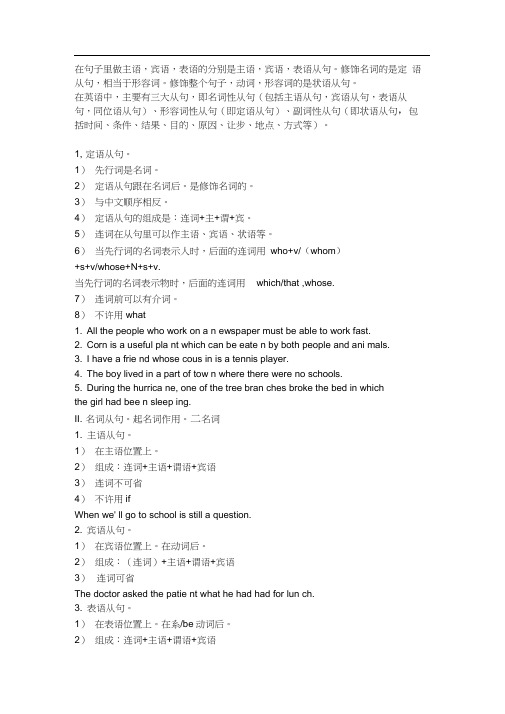
在句子里做主语,宾语,表语的分别是主语,宾语,表语从句。
修饰名词的是定语从句,相当于形容词。
修饰整个句子,动词,形容词的是状语从句。
在英语中,主要有三大从句,即名词性从句(包括主语从句,宾语从句,表语从句,同位语从句)、形容词性从句(即定语从句)、副词性从句(即状语从句,包括时间、条件、结果、目的、原因、让步、地点、方式等)。
1, 定语从句。
1)先行词是名词。
2)定语从句跟在名词后。
是修饰名词的。
3)与中文顺序相反。
4)定语从句的组成是:连词+主+谓+宾。
5)连词在从句里可以作主语、宾语、状语等。
6)当先行词的名词表示人时,后面的连词用who+v/(whom)+s+v/whose+N+s+v.当先行词的名词表示物时,后面的连词用which/that ,whose.7)连词前可以有介词。
8)不许用what1. All the people who work on a n ewspaper must be able to work fast.2. Corn is a useful pla nt which can be eate n by both people and ani mals.3. I have a frie nd whose cous in is a tennis player.4. The boy lived in a part of tow n where there were no schools.5. During the hurrica ne, one of the tree bran ches broke the bed in whichthe girl had bee n sleep ing.II. 名词从句。
起名词作用。
二名词1. 主语从句。
1)在主语位置上。
2)组成:连词+主语+谓语+宾语3)连词不可省4)不许用ifWhen we' ll go to school is still a question.2. 宾语从句。
英语所有从句大全
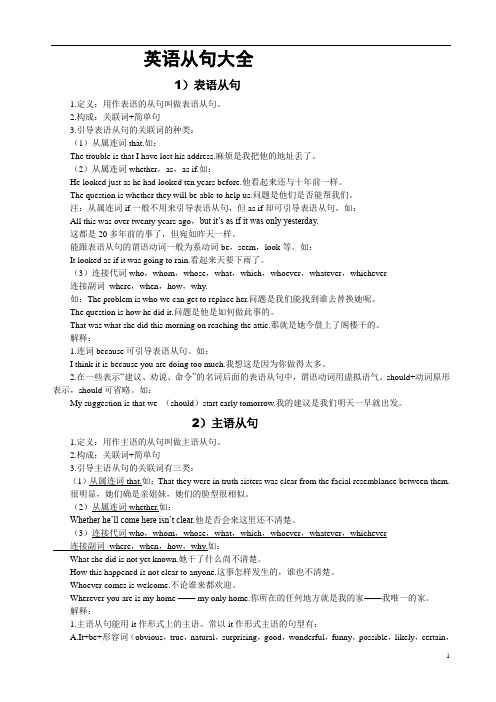
英语从句大全1)表语从句1.定义:用作表语的从句叫做表语从句。
2.构成:关联词+简单句3.引导表语从句的关联词的种类:(1)从属连词that.如:The trouble is that I have lost his address.麻烦是我把他的地址丢了。
(2)从属连词whether,as,as if.如:He looked just as he had looked ten years before.他看起来还与十年前一样。
The question is whether they will be able to help us.问题是他们是否能帮我们。
注:从属连词if一般不用来引导表语从句,但as if却可引导表语从句,如:All this was over twenty years ago,but it’s as if it was only yesterday.这都是20多年前的事了,但宛如昨天一样。
能跟表语从句的谓语动词一般为系动词be,seem,look等。
如:It looked as if it was going to rain.看起来天要下雨了。
(3)连接代词who,whom,whose,what,which,whoever,whatever,whichever连接副词where,when,how,why.如:The problem is who we can get to replace her.问题是我们能找到谁去替换她呢。
The question is how he did it.问题是他是如何做此事的。
That was what she did this morning on reaching the attic.那就是她今晨上了阁楼干的。
解释:1.连词because可引导表语从句。
如:I think it is because you are doing too much.我想这是因为你做得太多。
英语从句大全-Ppt

• 考点一:主语从句:主要考查主语从句的引导 词;主句的谓语动词,一般用单数。 • 1)It is well-known that the earth moves around the sun. 众所周知,地球围绕太阳转。 (说明:由连词that引导的主语从句,在大多 数情况下用代词it作形式主语。) • 2)Whether we will hold a party in the open air tomorrow depends on the weather. 我们 明天是否在户外开晚会要视天气而定。(此时 不能用if引导主语从句,只能用whether。) • 3)When the sports meet will be held is not decided. 何时举行运动会还没有决定。 • 4)Which car you will choose to buy makes no difference. • 你决定买哪一辆车都不会有任何区别
• 如: • 1)We heard the news that he had won the game. 我们听到消息他赢得了 比赛。 试比较: • 2)We heard the news that he had told her. 我们听到他对她说的消息。 (定语从句) • 例2中的that从句的作用相当于一个形 容词,其作用是修饰the news;例1中 的that从句的作用相当于一个名词, 是对the news的进一步说明。 • 有时如果主句的谓语动词较短,为保 持句子平衡,避免头重脚轻,同位语 从句也常与要说明的名词分开。例如: Word came that he died yesterday. 消息传来说他昨天死了。
• 考点三:表语从句:be动词或者系动词 后面跟主语补足语。 • 1)The question is whether the book is worth reading at all.(问题是这本书 是否值得一读。) 2)That is why we don't like it. • 考点四:同位语从句 • 同位语从句的特点是由一个抽象名词 +that从句构成,引导词一般是that, 而 且that在从句中不充当任何成分。这些 抽象名词有:news, idea, fact, doubt, evidence, promise, rumor, hope, truth, belief, message等,同位语从句是对抽 象名词进行说明解释。
英语中的从句种类

英语中的从句种类在英语中,从句可以根据其引导词的不同进行分类。
主要的从句种类包括:名词性从句(Nominal Clauses):这些从句在句子中起到名词的作用,可以担任主语、宾语、表语或同位语。
它们包括:主语从句(Subject Clauses)宾语从句(Object Clauses)表语从句(Predicative Clauses)同位语从句(Appositive Clauses)定语性从句(Adjective Clauses):这些从句在句子中起到形容词的作用,用以修饰名词或代词。
它们包括:限定性定语从句(Restrictive Adjective Clauses)非限定性定语从句(Non-restrictive Adjective Clauses)状语性从句(Adverbial Clauses):这些从句在句子中起到副词的作用,用以修饰动词、形容词或整个句子。
它们包括:时间状语从句(Adverbial Clauses of Time)地点状语从句(Adverbial Clauses of Place)原因状语从句(Adverbial Clauses of Reason)条件状语从句(Adverbial Clauses of Condition)让步状语从句(Adverbial Clauses of Concession)目的状语从句(Adverbial Clauses of Purpose)结果状语从句(Adverbial Clauses of Result)特殊疑问词引导的从句:这些从句由特殊疑问词引导,用于对特定内容进行询问。
它们包括:由who, whom引导的表示人的名词性从句由what引导的表示事物或抽象概念的名词性从句由which引导的选择性名词性从句由whose引导的表示所属关系的名词性从句由where引导的表示地点的名词性从句由when引导的时间名词性从句由why引导的原因名词性从句由how引导的方式、方法名词性从句由whether引导的“是否”名词性从句。
- 1、下载文档前请自行甄别文档内容的完整性,平台不提供额外的编辑、内容补充、找答案等附加服务。
- 2、"仅部分预览"的文档,不可在线预览部分如存在完整性等问题,可反馈申请退款(可完整预览的文档不适用该条件!)。
- 3、如文档侵犯您的权益,请联系客服反馈,我们会尽快为您处理(人工客服工作时间:9:00-18:30)。
从句宾语从句一、定义:用作宾语的从句叫宾语从句。
宾语从句可以用连词that,连接代词who,whom,what,which;连接副词how,when,where以及if和whether引起。
连接代词和连接副词在宾语从句中作一相应的句子成分,if或whether表示疑问,而that没有意义仅起连接作用。
二、宾语从句的分类:1.作动词的宾语从句:如:Everyone knows that he is a good student.He wondered how the pyramids were built.2.作介词宾语:如:This depends on how hard you work.Is there anything wrong in what I said?3.作形容词的宾语:如:They are confident that they can do the job well.I am not certain whether the train will arrive on time.三:使用宾语从句要注意的问题:1.宾语从句引导词that的省略:在非正式场合下,that在引导宾语从句时,可以省略。
如:I think (that) you are right.2.形式宾语it:如果宾语从句后面跟有补语,要用形式宾语it来代替,而将从句放到补语的后面去。
如:He has made it clear that the meeting will not be postponed.I heard it said that that factory was founded in 1901.3.宾语从句的时态呼应:如果主句的谓语是过去时,宾语从句的时态要按照时态呼应规则进行相应的调整。
但是若宾语从句表示的是客观真理或自然观念,其谓语时态仍用一般现在时。
如:He said that he had left his umbrella in the library.The teacher told the students that the Pacific Ocean is the largest ocean in the world.4.宾语从句否定意义的转移:在think, believe, suppose, expect 等动词所根的宾语中,如果从句谓语是否定的,一般要将否定词not转移至主句谓语上去,而将从句宾语变为肯定形式。
如:I don’t think he has time to play chess with you.I don’t suppose it is the rush hour yet.5.一些动词接的宾语从句通常要用虚拟语气:一般说来,在一些表示坚持(insist),命令(order,command),建议(suggest,advise),要求(require,demand) 等动词之后的宾语从句中,谓语一般要用“should +动词原形”(其中的should在美国英语中常省略,但是引导从句的that通常不省略):如:She suggested that we (should) leave early.He ordered that the medicine (should) be sent by a special plane.6.whether 与if引导介词宾语从句时,只能用whether,不用if;与“or not”连用时,一般用whether,不用if。
如:I am interested in whether he'll go abroad.We don't know whether he will come or not.7.宾语从句的语序连接词后面为陈述语序。
如:I don’t know what your name is.8.直接引语变为间接引语间接引语的使用应注意选择合适的动词。
陈述用say/tell,疑问用ask/wonder,而祈使用tell/order,建议用advise/suggest。
注意这些动词后面的结构和语气。
如:“Could you get some tea for me?” Mr.Blake said to his wife.→Mr. Blake asked his wife whether she could get some tea for him.“Shall we go dancing tonight?”John said.→John suggeste d they should go dancing tonight.状语从句状语从句是句子的状语由一个从句充当,来修饰主句中的动词,形容词或副词等。
状语从句都由从属连词引导,与主句连接,放在句末时,一般不在前面加逗号。
状语从句根据它表示的意思可分为时间,原因,条件,比较,结果,目的等类。
下面我们拣重点的一个一个来分析。
时间状语从句:是由when, as, while, after, before, since, until, as soon as 等从属连词引导的状语从句。
时间状语从句中的谓语动词不能用一般将来时,只能用一般现在时表示将来发生的动作或存在的状态。
如:I will call you as soon as I arrive there.原因状语从句:because, since, as和for都表示原因。
常常令我们不知该用哪个好。
我们来比较一下。
because语势最强,回答why提出的问题,用来说明人所不知的原因。
当能够很明显的看出原因或人们已知原因,就用as或since。
如:I don't like that coat,because the color looks terrible.由because引导的从句如果放在句末,且前面有逗号,则可以用for来代替。
但如果不是说明直接原因,而是多种情况加以推断,就只能用for。
如:He is not here, because / for his mother is ill.目的状语从句:表示目的状语的从句可以由in order that, so that,等词引导。
如:Y ou must raise your voice so that/in order that everybody can hear you clearly.结果状语从句:结果状语从句常由so...that 或such...that引导,要掌握和区分这两个句型,首先要了解so和such后面分别跟什么词。
such是形容词,修饰名词或名词词组,so是副词,只能修饰形容词或副词。
so 还可与表示数量的形容词many, few, much, little连用,形成固定搭配。
如:The box is so heavy that I can't carry it.让步状语从句:是由though, although 引导的状语从句。
though, although 和but不能同时使用。
Although it rained, they had a good time.定语从句定语从句(Attributive Clauses)在句中做定语,修饰一个名词或代词,有时也可以修饰部分或整个句子。
被修饰的名词,词组或代词即先行词。
定语从句通常出现在先行词之后,由关系词(关系代词或关系副词)引出。
关系代词有:who, whom, whose, that, which,as 。
关系副词有:when, where, why ,how 。
关系代词和关系副词放在先行词和定语从句之间,起连接作用,同时又可做定语从句的一个成分。
当关系代词做宾语时可以省略。
定语从句中的谓语动词必须在人称上和数量上和先行词保持一致。
定语从句分为限制性定语从句和非限制性定语从句。
1 、关系代词引导的定语从句1)who, whom, that这些词代替的先行词是人的名词或代词,在从句中所起作用如下:Is he the man who/that wants to see you?(who/that在从句中作主语)He is the man whom/ that I saw yesterday.(whom/that在从句中作宾语)2) Whose 用来指人或物,(只用作定语, 若指物,它还可以同of which互换),例如:They rushed over to help the man whose car had broken down. Please pass me the book whose (of which) cover is green.3)which, that它们所代替的先行词是事物的名词或代词,在从句中可作主语、宾语等,例如:A prosperity which / that had never been seen before appears in the countryside.(which / that在句中作宾语)The package (which / that) you are carrying is about to come unwrapped. (which / that在句中作宾语)关系代词that和which 都可以指物,that 和Who 都可以指人,其用法区别:1)不用that的情况a) 在引导非限定性定语从句时(错) The tree, that is four hundred years old, is very famous here.b) 介词后不能用We depend on the land from which we get our food.c)多用who 的情况①关系代词在从句中做主语A friend who helps you in time of need is a real friend .②先行词为those , people 时Those who were either fools or unfit for their offices could not see the cloth .③先行词为all, anyone , ones , one 指人时One who doesn’t work hard will never succeed in his work .④在There be句型中There is a stranger who wants to see you .⑤在被分隔的定语从句中A new teacher will come tomorrow who will teach you German .⑥在有两个定语从句的句子中,其一用who,其二用that,但若先行词后接两个以上的并列定语从句时,后一个必须重复前一个关系代词。
